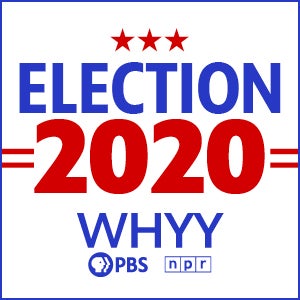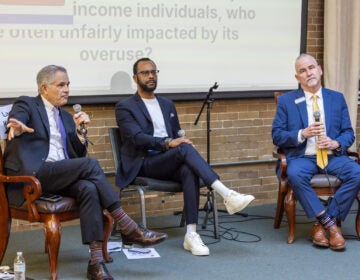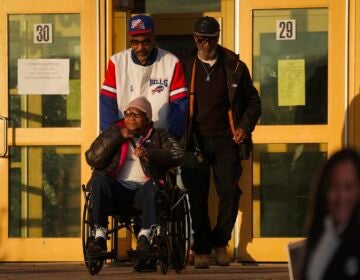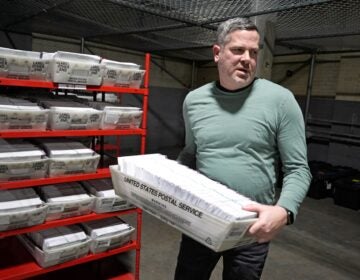With Pa.’s last-minute polling place changes, voters might get conflicting information
Amid a rush to consolidate polling places and update voters, a state web page for people to look up polling places may have been giving outdated information.
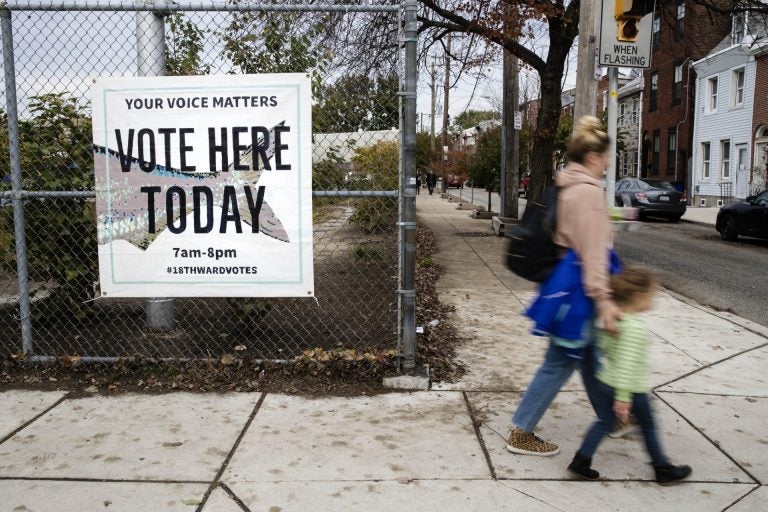
Pedestrians walk past a polling station on Election Day, Tuesday, Nov. 5, 2019 in Philadelphia. (Matt Rourke/AP Photo)
Are you on the front lines of the coronavirus? Help us report on the pandemic.
Almost 20,000 Pennsylvanians have visited the Department of State’s website during the past week to check where their polling place will be for the June 2 primary.
But during that time, many counties were still finalizing plans to move — and in some cases, significantly consolidate — those voting locations due to concerns over spreading COVID-19.
DoS officials acknowledge, there was no message or indication on the website alerting voters that polling place locations were changing, and that they should check back at a later date. That meant the voters visiting the site had no way of knowing if their polling place information was up to date.
About three dozen counties, home to more than 6.5 million registered Democrats and Republicans, are making polling place changes of some kind. Most were reflected on individual counties’ websites before this week.
But to get on the central website, counties have to change the address for each individual precinct manually in the Statewide Uniform Registry of Electors, or SURE, as Pennsylvania’s voter registration database is known. And for jurisdictions with hundreds of changes, that becomes a lengthy process — and a potentially untenable one given the pressure cooker local elections offices are currently in.
Wanda Murren, a spokeswoman for the department, said on Friday afternoon, some counties are still working on making updates.
Murren also said DOS is working to add language to indicate that polling place locations are subject to change on the page where voters would search for those polling places. She said based on past usage numbers, most people tend to visit the site in the week or so before Election Day, and urged voters to double-check their polling places shortly before the election to make sure nothing has changed.
She said the state has been alerting voters to check poll locations “in press releases, on our voter education website and on social media.”
DOS asked counties to complete their updates before the weekend.
Some voting rights advocates are worried that even with counties and the state working hard to make sure every voter knows where their polling place is, it might not be enough.
Quentin Palfrey, who heads the relatively new, Democratic-backed nonprofit the Voter Protection Corps, said he’s enthusiastically on board with states and counties urging people — as they have in Pennsylvania — to cast their ballots by mail during the pandemic.
However, he’s worried that in-person voting options, and the people who tend to use them, may suffer.
“There are some populations that historically have used vote-by-mail less, and have used in-person voting more, and those tend to be communities of color, homeless people, younger people,” he said. “You’re going to end up creating more barriers.”
Major polling place reorganizations in Philadelphia, Allegheny, Montgomery, Delaware and Luzerne counties were anticipated. But the details were still being hashed out until last week. In addition, comparatively minor moves were being figured out in Erie, York, Cambria, Lancaster and elsewhere. That includes dozens of precincts that officials had planned to relocate for reasons unrelated to the pandemic and will affect tens of thousands of voters.
In almost all counties making changes, county officials say they’re doing direct mail notices to voters, posting signs with new location information at the usual polling places, or both. (Normally, both actions are required, but counties can skip them for the 2020 primary under temporary pandemic-prompted rules.)
Greene and Lehigh counties are not taking either step. But they are advertising and alerting local media, with Lehigh pushing out information through its social media channels as well. Some jurisdictions are using ads, press releases and social platforms in addition to direct notices and, in some cases, alerting local Democratic and Republican committees.
Allegheny, Westmoreland and Carbon counties will use a combination of tactics to alert voters to changes. But they will not be reflected in the state’s system at all.
Westmoreland, Bedford and Carbon officials say that’s because virus-related changes are expected to be temporary. In Westmoreland, five of 300 polling places will be combined with other sites and 10 will move, according to election director Beth Lechman.
“We did not want our voters receiving wrong information for future elections,” Lechman said.
For Allegheny, the manual update proved too much as the county works double-time to juggle the return of mailed ballots and applications sent to every registered voter this spring.

Get daily updates from WHYY News!
Murren said that once the counties have finished updating their polling place locations, the state plans to “step up” its own messaging about the changes.
Starting on Saturday, the state is launching paid advertising spots and social media promotions encouraging voters to check their polling place locations on DOS’s online locator, or on their county websites, she said.
The state also maintains a voter assistance hotline once polls open on Election Day, at 1-877-VOTESPA or 1-877-868-3772.
Even with those efforts to get the word out, Palfrey worries that the kind of polling place consolidation that Philadelphia and other populous counties are undertaking will lead to long lines, confusion and, ultimately, people giving up and not voting in the primary.
He said at the very least, it’s important that states make decisions about changes to polling places “clearly and early.”
“A lot of folks are used to voting in the same place election after election,” he said. “If you’re going to change that, you need to be really clear about where people are supposed to vote, or they’re going to get left out.”
Pennsylvanians can no longer register to vote in the June 2 primary, but they can still request a mail-in ballot application from the state until May 26. Those ballots must be returned to the local county election office by 8 p.m. on June 2.
WHYY is your source for fact-based, in-depth journalism and information. As a nonprofit organization, we rely on financial support from readers like you. Please give today.



![CoronavirusPandemic_1024x512[1]](https://whyy.org/wp-content/uploads/2020/03/CoronavirusPandemic_1024x5121-300x150.jpg)
